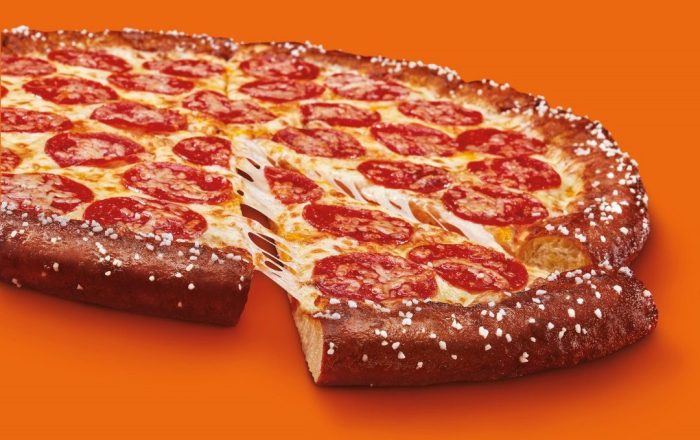Dive into the world of pretzels with our captivating Pretzel Trivia Questions and Answers! From their intriguing origins to their diverse flavors, this article unveils the fascinating secrets behind this beloved snack. Get ready to satisfy your curiosity and expand your pretzel knowledge!
Pretzels, with their distinctive shape and irresistible taste, have played a significant role in cultures across the globe. Their journey through history, the artistry involved in their creation, and the endless pairings they offer make them a culinary delight worthy of exploration.
Pretzel History and Origins

The pretzel, a distinctive baked good with a twisted shape and a glossy, salted exterior, has a rich and intriguing history that spans centuries and continents.
The origins of the pretzel are shrouded in uncertainty, with various theories and legends attempting to explain its creation. One widely accepted theory traces the pretzel’s roots to the 7th century, when Italian monks devised a baked good shaped like crossed arms in prayer as a reward for children who memorized their prayers.
This bread became known as “pretiola,” meaning “little reward,” and is believed to be the precursor to the modern pretzel.
Spread and Evolution
From its humble beginnings in Italy, the pretzel gradually spread throughout Europe, undergoing various adaptations and modifications along the way. In Germany, the pretzel became a popular food among commoners and royalty alike, and it was often used as a symbol of good luck and prosperity.
German bakers developed different variations of the pretzel, including the iconic three-hole pretzel and the elongated “stick” pretzel.
In the 18th and 19th centuries, German immigrants brought the pretzel to North America, where it quickly gained popularity. American bakers further innovated on the pretzel, creating new flavors and variations, such as the soft pretzel and the pretzel dog.
Cultural Significance
Throughout history, the pretzel has held cultural significance in different regions and time periods. In Germany, it has been associated with religious festivals and celebrations, and it is often served at weddings and other special occasions. In the United States, the pretzel has become a beloved snack food, enjoyed at sporting events, fairs, and casual gatherings.
Types of Pretzels

Pretzels come in various shapes, sizes, and flavors, each with its unique characteristics and appeal. From the classic hard pretzels to the soft and chewy varieties, there is a pretzel to satisfy every taste and preference.
The following table provides an overview of different types of pretzels, including their shapes, sizes, and flavors:
| Type | Shape | Size | Flavor |
|---|---|---|---|
| Hard Pretzels | Knotted or straight | Small to large | Salty, unsalted, or flavored (e.g., honey mustard, sour cream & onion) |
| Soft Pretzels | Knotted or braided | Small to large | Salty, unsalted, or flavored (e.g., cinnamon sugar, cheese) |
| Mini Pretzels | Tiny, bite-sized knots | Small | Salty, unsalted, or flavored (e.g., cheddar cheese, ranch) |
| Pretzel Sticks | Long, thin rods | Medium to large | Salty, unsalted, or flavored (e.g., garlic, herb) |
| Pretzel Rods | Thick, twisted rods | Medium to large | Salty, unsalted, or flavored (e.g., peanut butter, chocolate) |
| Pretzel Buns | Round, hamburger bun-shaped | Medium | Salty, unsalted, or flavored (e.g., sesame, poppy seed) |
In addition to the basic types listed above, there are also specialty pretzels, such as pretzel bites, pretzel chips, and pretzel popcorn. These variations offer unique textures and flavors, further expanding the diverse world of pretzels.
Pretzel Making Process

The process of making pretzels involves several distinct steps, each of which contributes to the unique flavor, texture, and shape of the finished product.
Dough Preparation
The first step in making pretzels is to prepare the dough. This typically involves combining flour, water, yeast, and salt. The ingredients are mixed together until a smooth, elastic dough forms. The dough is then allowed to rest for a period of time, allowing the yeast to activate and the dough to rise.
Shaping the Pretzels
Once the dough has risen, it is divided into individual pieces and shaped into pretzels. The traditional pretzel shape is created by rolling out a piece of dough into a long, thin strand, then folding it in half and crossing the ends over each other.
The ends are then twisted together to form the distinctive pretzel shape.
Boiling
After the pretzels have been shaped, they are boiled in a solution of water and baking soda. This step is essential for giving pretzels their characteristic chewy texture. The baking soda creates an alkaline environment that causes the proteins in the dough to gelatinize, resulting in a firm but pliable texture.
Baking
The final step in making pretzels is to bake them. The pretzels are placed on a baking sheet and baked in a hot oven until they are golden brown. During baking, the pretzels will expand and develop a crispy exterior.
Pretzel Trivia Questions and Answers
Pretzels, with their distinctive twisted shape and salty flavor, have a rich history and cultural significance. Engage in a delightful exploration of pretzel trivia, uncovering fascinating facts and expanding your knowledge of this beloved snack.
From their origins to their production process and cultural impact, this comprehensive collection of trivia questions and answers will satisfy your curiosity and deepen your appreciation for the humble yet extraordinary pretzel.
Origins and History, Pretzel trivia questions and answers
- When and where did pretzels originate?
Pretzels have a long and storied history, with their origins traced back to the 6th century AD in Southern Germany or Italy.
- What was the original purpose of pretzels?
Initially, pretzels were created as a reward for children who learned their prayers. The twisted shape was said to represent folded arms in prayer.
- How did pretzels become associated with Lent?
During Lent, when Christians abstained from meat and dairy, pretzels became a popular food source due to their simple ingredients and lack of animal products.
Production Process
- What are the key ingredients in a pretzel?
The basic ingredients of a pretzel are flour, water, yeast, salt, and lye.
- What is the purpose of lye in pretzel making?
Lye is a strong alkali that gives pretzels their distinctive dark brown color and chewy texture. It also helps create the characteristic blisters on the pretzel’s surface.
- How are pretzels shaped?
Pretzels are typically shaped by hand, with the dough being twisted into various forms, including the classic knot, rods, and sticks.
Cultural Significance
- In which country are pretzels considered a national symbol?
Pretzels are a national symbol of Germany, where they are known as “Brezeln” and hold a special place in the country’s culinary heritage.
- What is the significance of the pretzel in Pennsylvania Dutch culture?
In Pennsylvania Dutch culture, pretzels are a symbol of good luck and are often hung on Christmas trees or used as decorations during weddings.
- How are pretzels used in the United States?
In the United States, pretzels are enjoyed as a snack, used as a topping on salads, and even incorporated into desserts such as pretzel pies and cakes.
Pretzel Recipes
Pretzels are a versatile food that can be enjoyed in many different ways. From traditional German pretzels to modern-day innovations, there is a pretzel recipe out there for everyone.
Traditional German Pretzels
Traditional German pretzels are made with a simple dough of flour, water, yeast, and salt. The dough is shaped into a pretzel shape and then boiled in a baking soda solution. This gives the pretzels their characteristic chewy texture and brown color.
Ingredients:* 1 cup warm water (105-115°F)
- 1 tablespoon active dry yeast
- 1 tablespoon sugar
- 3 cups all-purpose flour
- 1 teaspoon salt
- 1/2 cup baking soda
- 8 cups water
Instructions:
- In a large bowl, dissolve the yeast and sugar in the warm water. Let sit for 5 minutes, until the yeast is foamy.
- Add the flour and salt to the yeast mixture and stir until a dough forms.
- Turn the dough out onto a floured surface and knead for 5-7 minutes, until smooth and elastic.
- Divide the dough into 12 equal pieces.
- Roll each piece of dough into a 24-inch rope.
- Shape the ropes into pretzels.
- In a large pot, bring the 8 cups of water and baking soda to a boil.
- Drop the pretzels into the boiling water and cook for 30 seconds.
- Remove the pretzels from the water and place them on a baking sheet.
- Sprinkle the pretzels with salt and bake at 450°F for 12-15 minutes, or until golden brown.
Pretzel Pairings

Pretzels, with their unique flavor and texture, offer a versatile canvas for culinary pairings. They complement a wide range of foods and beverages, enhancing the overall gastronomic experience.
The key to successful pretzel pairings lies in understanding their flavor profile and texture. Pretzels possess a slightly salty, nutty flavor with a crisp exterior and a soft, chewy interior. This combination provides a balance of flavors and textures that complements various culinary elements.
Dips and Sauces
- Mustard:The tangy and slightly acidic flavor of mustard pairs well with the salty and nutty notes of pretzels.
- Cheese Dip:Creamy and flavorful cheese dips, such as cheddar or nacho cheese, provide a rich and indulgent accompaniment to pretzels.
- Hummus:The earthy and nutty flavor of hummus complements the pretzel’s salty exterior, creating a harmonious balance.
- Chocolate Sauce:The sweet and creamy texture of chocolate sauce provides a decadent contrast to the salty and crispy nature of pretzels.
Beverages
- Beer:The malty and hoppy flavors of beer complement the salty and nutty notes of pretzels, making them a classic pairing.
- Wine:Crisp and acidic white wines, such as Sauvignon Blanc or Riesling, pair well with the salty and savory flavors of pretzels.
- Non-Alcoholic Beverages:Refreshing non-alcoholic beverages, such as lemonade or iced tea, provide a light and thirst-quenching accompaniment to pretzels.
Commonly Asked Questions
What is the origin of the pretzel shape?
The exact origin is unknown, but one theory suggests it represents folded arms in prayer, while another attributes it to a baker’s crossed arms.
What is the difference between a soft pretzel and a hard pretzel?
Soft pretzels are made with a dough that contains yeast, giving them a chewy texture. Hard pretzels are made with a dough that does not contain yeast, resulting in a crunchy texture.
What is the best way to store pretzels?
Pretzels should be stored in an airtight container at room temperature. They can last for several days, but their texture may become stale over time.